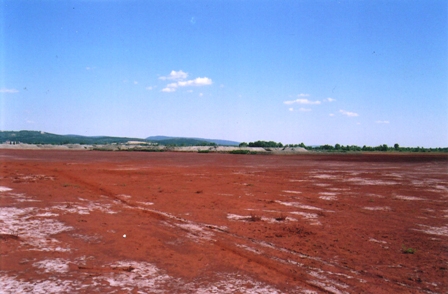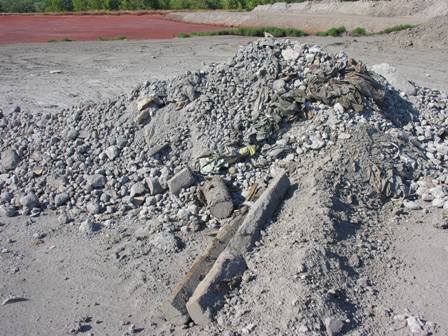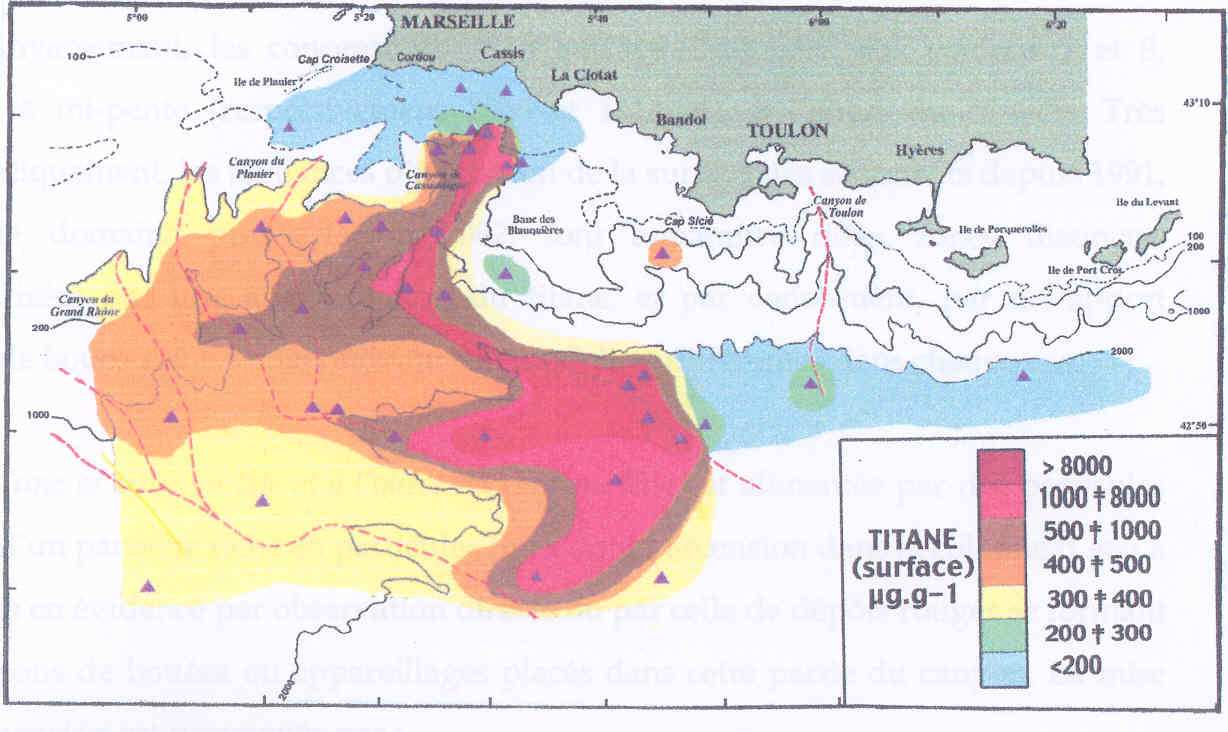Subject:: The Hungary Disaster
Characteristics: The processing of bauxite mineral with caustic soda to extract alumina produces red mud residual. Red mud contains caustic soda, iron, alumina, silicium, sodium, calcium, titanium, manganese, vanadium, hexavalent chromium, lead and cadmium. Because of the accumulation of all these metals and minerals red mud is a waste toxic for aquatic life, pets and farm animals. Cattle were intoxicated in Australia following the spreading of 20 tons of red mud per hectare which contained 1.8 kg of alumina, 24 kg of chloride and 6 kg of chrome. In fresh water, alumina is deadly for trout from 1.5 mg/litre and 3 mg of iron per litre is sufficient to inhibit the reproduction and to slow down the growth rate of numerous fish species. These figures are to be considered in the light of one million m3 which spilt out of the confinement dam in Hungary. It should be noted that red mud a by-product of bauxite processing is slightly radioactive. Red mud is a TENORM Technologically Enhanced Naturally Occurring Radioactive Material it contains radium 226 and thorium 232. This characteristic of red mud is recognised by the European Union and France. Red mud is three times more radioactive than bauxite.
Hungary’s red mud: The breaking of a red mud reservoir near Ajika was the cause of the accident. This type of event could have been the result of a number of factors such as periods of heavy rainfall which considerably raise the water level, inadequate dimensions of the reservoir, badly carried out heightening of the reservoir walls or poor maintenance. Another site in Hungary close to Tata in the North West of the country is clear evidence of poor handling of industrial waste. The red mud dumps covering dozens of hectares are situated by the Danube River, and are subject to flooding; furthermore the neighbouring villages are affected by flyaway dust. To reduce the amount of toxic dust escaping from the site the Hungarian authorities and the company producing the red mud have not found any better solution than to cover the red mud with ash from incinerators mixed with slag and discarded plastic.
 |
 |
Red mud dump overlooking the Danube River near Tata, covered with dangerous waste such as ash and slag
© Christine Bossard-Charlotte Nithart/Robin des Bois.
Consequences of the Ajka accident: The amount of liquid waste spilt is equivalent to 5 Amoco Cadiz or around 70 Erika. If, as the Hungarian authorities plan to do the red mud which is spread on buildings and on road networks is cleaned with high water pressure, it will be mixed with scrubbing water and will enter the water ecosystem, and eventually merge with the Danube River 110 km downstream after having impacted numerous wet lands. The mortality of fish, of water birds and of other sources of biodiversity in the surroundings will rocket up, both because of liming and because of the toxicity heading downstream to the Danube River. Once the Danube is reached, immediate and high death rates of adult fish are unlikely; however, environmental disturbances via the flow of the red mud and the movement of the fine particles will have long term negative effects on fish egg development and on larva growth as well as on all aquatic species reproduction capacities.
The immediate sanitary effects for the population are external or internal burns from contact or by ingestion of water containing caustic soda. The same consequences are foreseeable for pets and farm animals. Long term health consequences include the risk of food chain contamination of agricultural products and groundwater contamination by heavy metals. Another vector of contamination in these polluted areas for the local populations is the quick drying up of mud into inhalable dust.
Red mud in France: They are mostly rejected in the Cassidaigne trench near Cassis in the Mediterranean. To date 40 million tons have been rejected. A pipe links Gardanne alumina production plant to the reject point at sea, this pipe has often leaked because of the causticity of the effluent. This leaking can be quickly spotted and has repeatedly polluted local rivers.
The « ad hoc » Monitoring Committee on the follow up of red mud rejected into the sea off the coast of Cassis is not representative. There are no participants from environmental associations. It was following numerous objections by the locals and a report by Robin des Bois commissioned by the Autorité de Sûreté Nucléaire (French Safety Authority) which indicated a significant presence of long-half life radionuclides in red mud this led the exploiting industry and government to put in place a plan to reduce discharges into the sea which still amounts to 200,000 tons per year to date. The Barcelona Convention for the Protection of the Mediterranean Sea Against Pollution has also played an active role in the reduction of these releases. The company exploiting the site says that the zero discharge goal will be reached by 2015. Robin des Bois believes that this goal will indeed be reached and that the old factory will be closed as it is situated in a built up area it also requires important investments and has recently benefited from an exemption on nitrogen dioxide atmospheric pollution. A plume of contaminated sediments on the seabed now extends as far as 60km from the discharge point. Incomplete information obtained from a confidential Créocéan report shows that even in small doses red mud from Gardanne has very high toxicity effects on the growth of oyster larvae and on the reproduction cycle of urchins.
“The presence of titanium in surface sediments over the entire site”.
Extract from the 2003 yearly report by the Scientific Monitoring Committee of Gardanne waste rejects.
Available on the following link (in French) http://www.alcan-gardanne-environnement.fr/File/RAPPORT%20ANNUEL%202003.pdf
More information (in French) is available in the following documents
Chapitre bauxite, extrait du rapport “La radioactivité naturelle technologiquement renforcée”
Robin des Bois – December 2005.
“Le Pastis de Pechiney” Article in « La Flèche n°33 », News magazine – Robin des Bois – 1999.
European law context: Following similar disasters –though the toxic effluents were of a different nature- the Aznalcollar in Spain (Andalousie) in 1998 and the Baia Mare (Romania) in 2000, the European Union has set up a directive on waste management from extractive industries. It calls member states to setup an inventory of waste facilities, to reinforce security measures and the physical stability of the site, but also for the implementation of good practices and precautionary measures to limit risk to public health and the environment. In France this inventory is underway.
Furthermore, the environmental disaster should be considered as a cross-boarder disaster as it threatens other countries along the Danube River Croatia, Serbia, Bulgaria, Moldavia, Ukraine and Romania as such it should be subject to specific information processes and proper monitoring within the framework of the International Commission for the Protection of The Danube River which in the case of a serious disaster benefits from an emergency alarm.
 Imprimer cet article
Imprimer cet article









